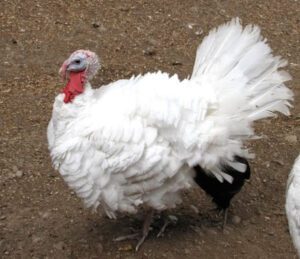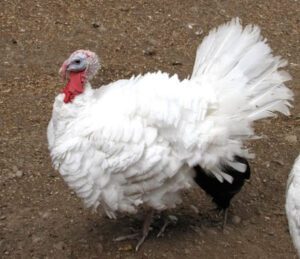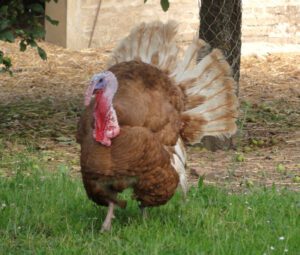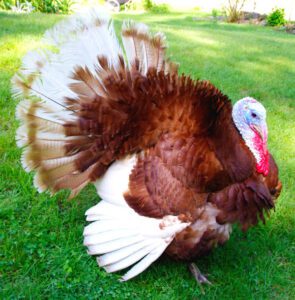The Narragansett turkey is a breed of Meleagris gallopavo which was developed from the United States. It was developed from a cross between the eastern wild turkey and the domestic turkey.
It is a ‘historic variety’ unique to North America and the breed is named for Narragansett Bay. The breed was never as popular as the Bronze turkey, but it was still valued for commercial agriculture across the United States.
The Narragansett turkey became the foundation of the turkey industry in New England and was especially important in Rhode Island and Connecticut.
The breed was also popular in the Mid-Atlantic States and the Midwest. And it was recognized by the American Poultry Association in 1874.
Popularity of the Bronze turkey grew even more in the early twentieth century, and the Narragansett turkey soon became a rarity. Until the early 21st century it was not commercially cultivated for many decades.
Today the breed is raised mainly for meat production. Read some more information about the Narragansett turkey breed below.
Narragansett Turkey Characteristics
The Narragansett turkeys are large birds with very beautiful appearance. They have beautiful plumage with black, tan, gray and white feathers. They resemble the Bronze turkeys, but have feathers of gray or dull black replacing the Bronze’s distinctive coppery coloring. The Narragansett turkeys occasionally have bars of white feathers on their wings due to a genetic mutation not found outside the United States.

These birds have a black beard, a horn-colored beak, and a mostly featherless head and neck which range in color from red to blueish white. Average live body weight of the mature Narragansett toms is around 10 to 12.7 kg. And average live body weight of the mature hens is between 5.5 and 7.25 kg. Photo and info from Wikipedia.
Uses
The Narragansett turkey is a very beautiful bird. It is mainly raised for meat production. But some people also raise them for ornamental purpose or as a hobby.
Special Notes
The Narragansett turkeys are strong and hardy birds. They are prized for their excellent temperament combining a calm disposition with very good maternal abilities. They are well known for their early maturation, egg production and excellent meat quality. They were well regarded for production qualities as recently as 50 years ago.
The Narragansett turkeys can run quickly, fly well and prefer to spend their nights roosting in trees. They are excellent foragers, and they generally forage for insects, crickets and grasshoppers. And they can be maintained with little supplemental feeds. However, review full breed profile of the Narragansett turkey in the chart below.
| Breed Name | Narragansett |
| Other Names | None |
| Breed Purpose | Mainly meat also ornamental |
| Special Notes | Very strong and hardy birds, excellent temperament, calm disposition, the hens have very good maternal abilities, well known for their early maturation, hens are good egg producers, excellent meat quality, can run quickly, can fly well, prefer to spend their nights roosting in trees, excellent foragers, generally forage for insects, crickets and grasshoppers, can be raised with little supplemental feeds |
| Breed Size | Medium to large |
| Tom | 10 to 13.7 kg |
| Hen | 5.5 to 7.25 kg |
| Climate Tolerance | Almost all climates |
| Color | Beautiful plumage with black, tan, grey and white feathers |
| Rarity | Common |
| Country/Place of Origin | United States |






What distinguishes Narragansett turkeys from other turkey breeds, and what is their historical significance in American poultry farming?
Narragansett turkeys are a heritage breed known for their unique coloration and historical importance in American poultry farming. What sets them apart is their striking appearance with black feathers intermingled with a soft gray or tan. These contrasting colors give them a distinctive and attractive appearance. Narragansett turkeys were prevalent in the United States during the 18th and 19th centuries, particularly in the Narragansett Bay area of Rhode Island, from which they derive their name. They were highly regarded for their excellent meat quality and were a popular choice for both home and commercial turkey production.
Their historical significance lies in their role as one of the foundation breeds for the development of the Broad Breasted Bronze turkey, which became the dominant commercial turkey breed in the 20th century. Narragansett turkeys, along with other heritage breeds, have seen a resurgence in popularity in recent years due to their superior flavor and texture compared to commercial varieties. Today, Narragansett turkeys are prized by small-scale farmers and enthusiasts for their historical value, adaptability, and delicious meat, contributing to the preservation of this heritage breed in American agriculture. Good luck!